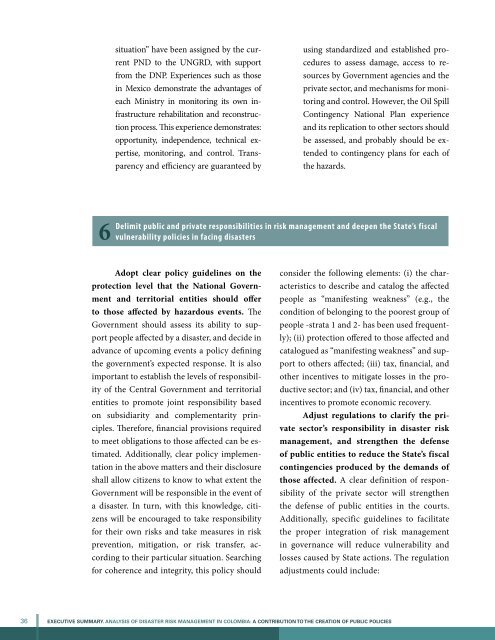Executive Summary - GFDRR
Executive Summary - GFDRR
Executive Summary - GFDRR
You also want an ePaper? Increase the reach of your titles
YUMPU automatically turns print PDFs into web optimized ePapers that Google loves.
situation” have been assigned by the current<br />
PND to the UNGRD, with support<br />
from the DNP. Experiences such as those<br />
in Mexico demonstrate the advantages of<br />
each Ministry in monitoring its own infrastructure<br />
rehabilitation and reconstruction<br />
process. This experience demonstrates:<br />
opportunity, independence, technical expertise,<br />
monitoring, and control. Transparency<br />
and efficiency are guaranteed by<br />
using standardized and established procedures<br />
to assess damage, access to resources<br />
by Government agencies and the<br />
private sector, and mechanisms for monitoring<br />
and control. However, the Oil Spill<br />
Contingency National Plan experience<br />
and its replication to other sectors should<br />
be assessed, and probably should be extended<br />
to contingency plans for each of<br />
the hazards.<br />
6<br />
Delimit public and private responsibilities in risk management and deepen the State’s fiscal<br />
vulnerability policies in facing disasters<br />
Adopt clear policy guidelines on the<br />
protection level that the National Government<br />
and territorial entities should offer<br />
to those affected by hazardous events. The<br />
Government should assess its ability to support<br />
people affected by a disaster, and decide in<br />
advance of upcoming events a policy defining<br />
the government’s expected response. It is also<br />
important to establish the levels of responsibility<br />
of the Central Government and territorial<br />
entities to promote joint responsibility based<br />
on subsidiarity and complementarity principles.<br />
Therefore, financial provisions required<br />
to meet obligations to those affected can be estimated.<br />
Additionally, clear policy implementation<br />
in the above matters and their disclosure<br />
shall allow citizens to know to what extent the<br />
Government will be responsible in the event of<br />
a disaster. In turn, with this knowledge, citizens<br />
will be encouraged to take responsibility<br />
for their own risks and take measures in risk<br />
prevention, mitigation, or risk transfer, according<br />
to their particular situation. Searching<br />
for coherence and integrity, this policy should<br />
consider the following elements: (i) the characteristics<br />
to describe and catalog the affected<br />
people as “manifesting weakness” (e.g., the<br />
condition of belonging to the poorest group of<br />
people -strata 1 and 2- has been used frequently);<br />
(ii) protection offered to those affected and<br />
catalogued as “manifesting weakness” and support<br />
to others affected; (iii) tax, financial, and<br />
other incentives to mitigate losses in the productive<br />
sector; and (iv) tax, financial, and other<br />
incentives to promote economic recovery.<br />
Adjust regulations to clarify the private<br />
sector’s responsibility in disaster risk<br />
management, and strengthen the defense<br />
of public entities to reduce the State’s fiscal<br />
contingencies produced by the demands of<br />
those affected. A clear definition of responsibility<br />
of the private sector will strengthen<br />
the defense of public entities in the courts.<br />
Additionally, specific guidelines to facilitate<br />
the proper integration of risk management<br />
in governance will reduce vulnerability and<br />
losses caused by State actions. The regulation<br />
adjustments could include:<br />
36 EXECUTIVE SUMMARY. ANALYSIS OF DISASTER RISK MANAGEMENT IN COLOMBIA: A contribution TO the creation of public policies

















